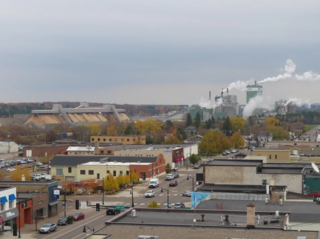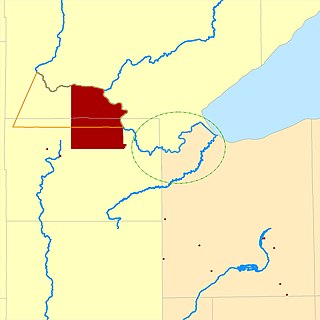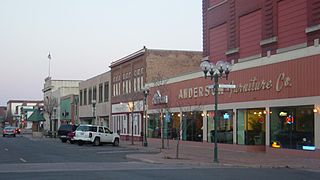Related Research Articles

Duluth is a port city in the U.S. state of Minnesota and the county seat of St. Louis County. Located on Lake Superior in Minnesota's Arrowhead Region, the city is a hub for cargo shipping. Commodities shipped from the Port of Duluth include coal, iron ore, grain, limestone, cement, salt, wood pulp, steel coil, and wind turbine components. Duluth is south of the Iron Range and the Boundary Waters Canoe Area Wilderness.

Carlton County is a county in the State of Minnesota, formed in 1857. As of the 2020 census, the population was 36,207. Its county seat is Carlton. Part of the Fond du Lac Indian Reservation lies in northeastern Carlton County.

Cloquet is a city in Carlton County, Minnesota, United States, at the junction of Interstate 35 and Minnesota State Highway 33. Part of the city lies within the Fond du Lac Indian Reservation and serves as one of the reservation's three administrative centers. The population was 12,568 at the 2020 census.

Hinckley is a city in Pine County, Minnesota, United States, located at the junction of Interstate 35 and Minnesota State Highway 48. The population was 1,800 at the 2010 census.
Several places and things have this name including:

The Duluth MN–WI Metropolitan Area, commonly called the Twin Ports, is a small metropolitan area centered around the cities of Duluth, Minnesota and Superior, Wisconsin. The Twin Ports are located at the western part of Lake Superior and together are considered one of the larger cargo ports in the United States. The Twin Ports are close to many natural attractions such as the North Shore, the Apostle Islands, and the Superior National Forest.

The Fond du Lac Indian Reservation is an Indian reservation in northern Minnesota near Cloquet in Carlton and Saint Louis counties. Off-reservation holdings are located across the state in Douglas County, in the northwest corner of Wisconsin. The total land area of these tribal lands is 154.49 square miles (400.1 km2). It is the land-base for the Fond du Lac Band of Lake Superior Chippewa. Before the establishment of this reservation, the Fond du Lac Band of Lake Superior Chippewa were located at the head of Lake Superior, closer to the mouth of the Saint Louis River, where Duluth has developed.

Fond du Lac Band of Lake Superior Chippewa is an Anishinaabe (Ojibwe) band located near Cloquet, Minnesota. Their land base is the Fond du Lac Indian Reservation, located mainly in Carlton and Saint Louis Counties, Minnesota, 20 miles west of Duluth.

Lincoln Park is one of the larger neighborhoods in the city of Duluth, Minnesota, United States.

Jay Cooke State Park is a state park of Minnesota, United States, protecting the lower reaches of the Saint Louis River. The park is located about 10 miles (16 km) southwest of Duluth and is one of the ten most visited state parks in Minnesota. The western half of the park contains part of a rocky, 13-mile (21 km) gorge. This was a major barrier to Native Americans and early Europeans traveling by canoe, which they bypassed with the challenging Grand Portage of the St. Louis River. The river was a vital link connecting the Mississippi waterways to the west with the Great Lakes to the east.

Minnesota Point, also known as the Park Point neighborhood of Duluth, Minnesota, United States; is a long, narrow sand spit that extends out from the Canal Park tourist recreation-oriented district of the city of Duluth. The Point separates Lake Superior from Superior Bay and the Duluth Harbor Basin.
The Oneota neighborhood is located within the West Duluth district of Duluth, Minnesota, United States. The neighborhood was named for the prehistoric Oneota Native American culture.
Gary – New Duluth is a neighborhood in Duluth, Minnesota, United States. Although called Gary–New Duluth by most people in the area, and even identified by local traffic signs as being so named, they are two separate neighborhood communities.

East End / Endion is a neighborhood in Duluth, Minnesota, United States.

The Oliver Bridge is a bridge across the Saint Louis River. It was constructed in 1910 as a railway bridge by the Interstate Transfer Railway Company, a Wisconsin corporation, under special federal authorization from the 60th United States Congress. A lower deck carrying road traffic was constructed in 1917 It connects the Gary – New Duluth neighborhood in Duluth, Minnesota with the village of Oliver, Wisconsin. The bridge is 1,889 feet (576 m) long and is principally of steel truss construction.

The Snake River Trading Post is a reconstructed fur trade post on the Snake River west of Pine City, Minnesota, United States of America. The post was established in the fall of 1804 by John Sayer, a partner in the North West Company, and built by his crew of voyageurs. The site operated for several years, although its exact period of operation is unknown. It was later destroyed by fire.
Fond du Lac Tribal and Community College (FDLTCC) is a public tribal land-grant community college in Cloquet, Minnesota. FDLTCC is located within the Twin Ports area of Duluth, Minnesota and Superior, Wisconsin in northeastern Minnesota. The college is a member of Minnesota State, the American Indian Higher Education Consortium, and the World Indigenous Nations Higher Education Consortium. FDLTCC was Minnesota's first tribal college. FDLTCC is the only college in the nation both established as a tribal college under federal law and operating as part of a state-funded higher education system.

Bridge 5757 or the Fond du Lac Culvert is a historic bridge in the Fond du Lac neighborhood of Duluth, Minnesota, United States. It was built in 1937 to carry Minnesota State Highway 23 over Mission Creek. It is a double-span culvert built using a modular, corrugated iron product called "multi-plate", with granite headwalls. The creek flows through two 20-foot (6 m) metal culverts that are 115 feet (35 m) wide. The bridge was part of a 0.75-mile (1.2 km) section of Highway 23 built as a wide, shaded, parkway-like divided highway known as Veterans' Evergreen Memorial Highway.
Fond du Lac Ojibwe School is a K–12 tribal school in Cloquet, Minnesota. The Fond du Lac Band of Lake Superior Chippewa operates the school and owns the facilities.

Margaret Bonga Fahlstrom was a mixed-race woman of African and Ojibwe descent who came from a fur trading family in the Great Lakes region. In 1823, she married Jacob Fahlstrom, the first Swedish settler in Minnesota, and lived with him on a small farm at Coldwater Spring near Fort Snelling. Margaret was one of the few free Black women living in the area around the time that enslaved women such as Harriet Robinson Scott were struggling to find a path to freedom. In 1838, the Fahlstroms became the first converts to the Methodist faith in Minnesota, and moved to a farm in Washington County in 1840. Jacob became well known as the Methodist lay preacher "Father Jacob". His success as a traveling Christian missionary was often attributed to his fluency in the Ojibwe language, as well as his marriage. Margaret and her daughters were also known for their involvement in early church meetings in Minnesota, and their hospitality toward Methodist circuit riders.
References
- ↑ "MnDOT Historic Roadside Development Structures Inventory: Fond du Lac Culvert (Bridge 5757)" (PDF). Minnesota Department of Transportation. 1998. Retrieved 2009-09-10.
- ↑ "Census of Population and Housing". Census.gov. Retrieved June 12, 2019.